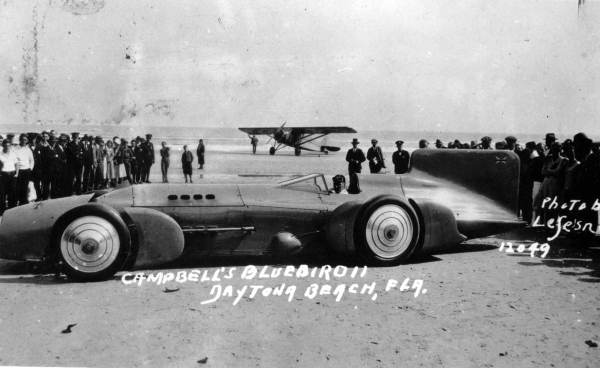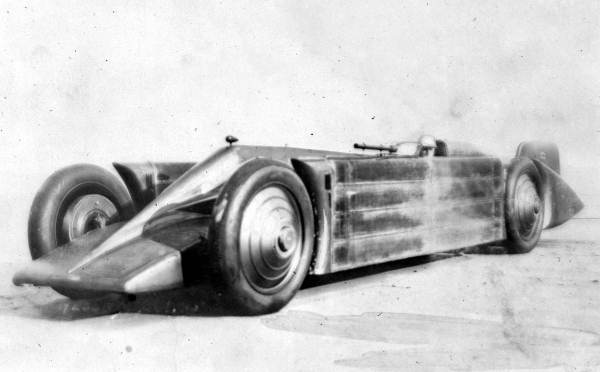|
Campbell-Napier-Railton Blue Bird
The Campbell-Napier-Railton Blue Bird was a land speed record car driven by Malcolm Campbell. After Henry Segrave's Golden Arrow, clearly a more powerful engine was required for ''Blue Bird'', with a chassis and transmission to handle it. A supercharged Napier Lion VIID was used, with over three times the power of the previous Blue Bird and a large premium over Golden Arrow's unsupercharged Lion VIIA. This was not the first use of supercharging for Land Speed Record cars, but was the first combining supercharging with the large displacement aero engines that had previously been relied upon for their gross output. Golden Arrow's innovative vertical aerodynamic stabilising fin was also used, a first for Campbell. Campbell's nemesis Segrave was killed in an attempt on the water speed record while Campbell was scouting for new record courses in South Africa. On his return, Campbell set off for Daytona with the new ''Blue Bird'', concerned at American challenges to the record ... [...More Info...] [...Related Items...] OR: [Wikipedia] [Google] [Baidu] |
Napier-Campbell Blue Bird
The Napier-Campbell Blue Bird was a land speed record car driven by Malcolm Campbell. Its designer was C. Amherst Villiers and Campbell's regular mechanic Leo Villa supervised its construction. This was Campbell's first car to use the Napier Lion aero engine. His intention was to surpass his previous Sunbeam ''Blue Bird'''s achievement of the 150 mph barrier and to reach 200 mph. 1927 When first built, the car used a Napier Lion engine of around 500 bhp. It was of conventional form with a front-mounted vertical radiator and the driver behind the engine. The three banks of the W-12 engine were hidden behind bulges in the narrow bonnet, with exhaust stub pipes protruding. Bluebird's first record attempt was on 4 February 1927 at Pendine Sands. A peak speed of was achieved, tantalisingly close to the magic , but the two-way average recorded for the record was lower, at . 1928 The 1927 record was short-lived, as Segrave's Sunbeam 1000 hp achieved both the ... [...More Info...] [...Related Items...] OR: [Wikipedia] [Google] [Baidu] |
Henry Segrave
Sir Henry O'Neal de Hane Segrave (22 September 1896 – 13 June 1930) was an early British pioneer in land speed and water speed records. Segrave, who set three land and one water record, was the first person to hold both titles simultaneously and the first person to travel at over in a land vehicle. He died in an accident in 1930 shortly after setting a new world water speed record on Windermere in the Lake District, England. The Segrave Trophy was established to commemorate his life. Early life Segrave, who was a British national, was born on 22 September 1896 in Baltimore, Maryland, to an American mother and an Irish father. He was raised in Ireland and attended Eton College in England. He spent some time at 'Belle Isle' house, near Portumna and learnt to drive the family houseboat. He is reported to have attended the North Shannon Yacht Club regatta on Lough Boderg between Leitrim and Roscommon. First World War At the outbreak of war the Sandhurst officer training cour ... [...More Info...] [...Related Items...] OR: [Wikipedia] [Google] [Baidu] |
Vehicles Powered By Napier Lion Engines
A vehicle (from la, vehiculum) is a machine that transports people or cargo. Vehicles include wagons, bicycles, motor vehicles (motorcycles, cars, trucks, buses, mobility scooters for disabled people), railed vehicles (trains, trams), watercraft (ships, boats, underwater vehicles), amphibious vehicles (screw-propelled vehicles, hovercraft), aircraft (airplanes, helicopters, aerostats) and spacecraft.Halsey, William D. (Editorial Director): ''MacMillan Contemporary Dictionary'', page 1106. MacMillan Publishing, 1979. Land vehicles are classified broadly by what is used to apply steering and drive forces against the ground: wheeled, tracked, railed or skied. ISO 3833-1977 is the standard, also internationally used in legislation, for road vehicles types, terms and definitions. History * The oldest boats found by archaeological excavation are logboats, with the oldest logboat found, the Pesse canoe found in a bog in the Netherlands, being carbon dated to 8040 ... [...More Info...] [...Related Items...] OR: [Wikipedia] [Google] [Baidu] |
Bluebird Record-breaking Vehicles
The bluebirds are a North American group of medium-sized, mostly insectivorous or omnivorous birds in the order of Passerines in the genus ''Sialia'' of the thrush family (Turdidae). Bluebirds are one of the few thrush genera in the Americas. Bluebirds have blue, or blue and rose beige, plumage. Female birds are less brightly colored than males, although color patterns are similar and there is no noticeable difference in size. Taxonomy and species The genus ''Sialia'' was introduced by the English naturalist William John Swainson in 1827 with the eastern bluebird (''Sialia sialis'') as the type species. A molecular phylogenetic study using mitochondrial sequences published in 2005 found that ''Sialia'', ''Myadestes'' (solitaires) and ''Neocossyphus'' (African ant-thrushes) formed a basal clade in the family Turdidae. Within ''Sialia'' the mountain bluebird was sister to the eastern bluebird. The genus contains three species: Behavior Bluebirds are territorial and prefe ... [...More Info...] [...Related Items...] OR: [Wikipedia] [Google] [Baidu] |
Daytona Beach Road Course
The Daytona Beach and Road Course was a race track that was instrumental in the formation of the National Association for Stock Car Auto Racing. It originally became famous as the location where 15 world land speed records were set. Beach and road course Track layout The course started on the pavement of highway A1A (at 4511 South Atlantic Avenue, Ponce Inlet ). A restaurant named "Racing's North Turn" now stands at that location. It went south parallel to the ocean on A1A (S. Atlantic Ave) to the end of the road, where the drivers accessed the beach at the south turn at the Beach Street approach , returned north on the sandy beach surface, and returned to A1A at the north turn. The lap length in early events was , and it was lengthened to in the late 1940s. In the video game ''NASCAR Thunder 2004'' by EA Sports, the course is shortened to about half its distance, but still shows how the basic course was set up. Early events March 29, 1927 Major Henry Segrave and his Sunbe ... [...More Info...] [...Related Items...] OR: [Wikipedia] [Google] [Baidu] |
Golden Arrow (land Speed Racer)
Golden Arrow was a land speed record racer built in Britain to regain the world land speed record from the USA. Henry Segrave drove the car at 231.45 mph (372.46 km/h) in March 1929 on Daytona Beach, exceeding the previous record by 24 mph (39 km/h). The car Built for ex-Sunbeam racing driver Major Henry Segrave to take the Land Speed Record from Ray Keech, ''Golden Arrow'' was one of the first streamlined land speed racers, with a pointed nose and tight cowling. Power was provided by a 23.9 litre (1462 ci) W12 Napier Lion VIIA aeroengine, specially prepared by Napiers, designed for the Supermarine aircraft competing in the Schneider Trophy, producing 925 hp (690 kW) at 3300 rpm. The car was designed by ex-Sunbeam engineer, aero-engine designer and racing manager Captain John Samuel Irving (1880-1953).Captain J. S. Irving. ''The Times'', Tuesday, 31 Mar 1953; pg. 8; Issue 52584. It featured ice chests in the sides through which coolant ran and a telescop ... [...More Info...] [...Related Items...] OR: [Wikipedia] [Google] [Baidu] |
Bluebird Land Speed Record Car 1931 Pr09069
The bluebirds are a North American group of medium-sized, mostly insectivorous or omnivorous birds in the order of Passerines in the genus ''Sialia'' of the thrush family (Turdidae). Bluebirds are one of the few thrush genera in the Americas. Bluebirds have blue, or blue and rose beige, plumage. Female birds are less brightly colored than males, although color patterns are similar and there is no noticeable difference in size. Taxonomy and species The genus ''Sialia'' was introduced by the English naturalist William John Swainson in 1827 with the eastern bluebird (''Sialia sialis'') as the type species. A molecular phylogenetic study using mitochondrial sequences published in 2005 found that ''Sialia'', ''Myadestes'' (solitaires) and ''Neocossyphus'' (African ant-thrushes) formed a basal clade in the family Turdidae. Within ''Sialia'' the mountain bluebird was sister to the eastern bluebird. The genus contains three species: Behavior Bluebirds are territorial and prefe ... [...More Info...] [...Related Items...] OR: [Wikipedia] [Google] [Baidu] |
Campbell-Railton Blue Bird
The Campbell-Railton Blue Bird was Sir Malcolm Campbell's final land speed record car. His previous Campbell-Napier-Railton Blue Bird of 1931 was rebuilt significantly. The overall layout and the simple twin deep chassis rails remained, but little else. The bodywork remained similar, with the narrow body, the tombstone radiator grille and the semi-spatted wheels, but the mechanics were new. Most significantly, a larger, heavier and considerably more powerful Rolls-Royce R V12 engine replaced the old Napier Lion, again with supercharger. This required two prominent "knuckles" atop the bodywork, to cover the V12 engine's camboxes. many period photos 1933 ''Blue Bird's'' first run was back at Daytona, setting a record of on 22 February 1933. Campbell now had a car with all the power that he could want, but no way to use all of it. Wheelspin was a problem, losing perhaps from the top speed. 1935 Visually the car was quite different. The bodywork was now rectangular in cross s ... [...More Info...] [...Related Items...] OR: [Wikipedia] [Google] [Baidu] |
Malcolm Campbell
Major Sir Malcolm Campbell (11 March 1885 – 31 December 1948) was a British racing motorist and motoring journalist. He gained the world speed record on land and on water at various times, using vehicles called ''Blue Bird'', including a 1921 Grand Prix Sunbeam. His son, Donald Campbell, carried on the family tradition by holding both land speed and water speed records. Early life and family Campbell was born on 11 March 1885 in Chislehurst, Kent, the only son of William Campbell, a Hatton Garden diamond seller. He attended the independent Uppingham School. In Germany, learning the diamond trade, he gained an interest in motorbikes and races. Returning to Britain, he worked for two years at Lloyd's of London for no pay, then for another year at £1 a week. Between 1906 and 1908, he won all three London to Land's End Trials motorcycle races. In 1910, he began racing cars at Brooklands. He christened his car ''Blue Bird'', painting it blue, after seeing the play '' The Blue ... [...More Info...] [...Related Items...] OR: [Wikipedia] [Google] [Baidu] |
J Gurney Nutting & Co Limited
J Gurney Nutting & Co Limited was an English firm of bespoke coachbuilders specialising in sporting bodies founded in 1918 as a new enterprise by a Croydon firm of builders and joiners of the same name. The senior partner was John (Jack) Gurney Nutting (1871–1946). Nutting had done well from wartime government building contracts and with his partner from that business, a man named Cresswell, they set up operations in the old Marlborough Carriage Works in Oval Road, Croydon. The first Gurney Nutting designs made their appearance at the London Motor Show in October 1920. In 1921 they displayed their 'all weather' body, the roof folded in the usual way but the side windows simply lowered into the doors. After the Croydon premises were destroyed by fire during Easter 1923 the business was moved nearer their customers to the upmarket address of Elystan Street, off King's Road in Chelsea, London. Chelsea In Chelsea, which had been an artists' colony, Gurney Nutting established ... [...More Info...] [...Related Items...] OR: [Wikipedia] [Google] [Baidu] |


.jpg)




.jpg)

